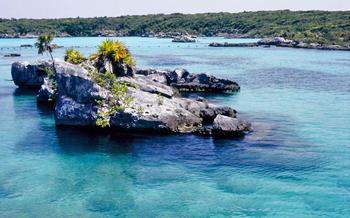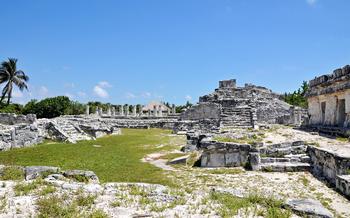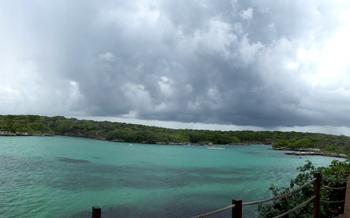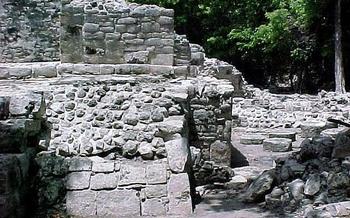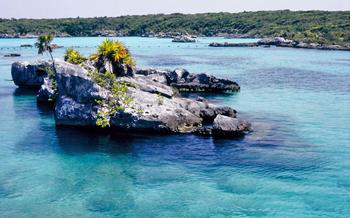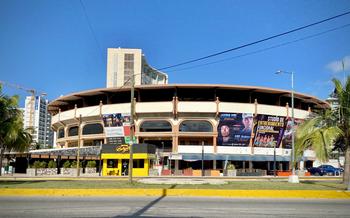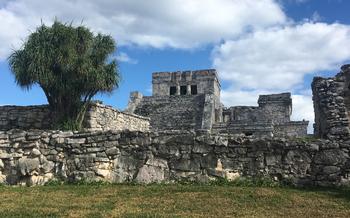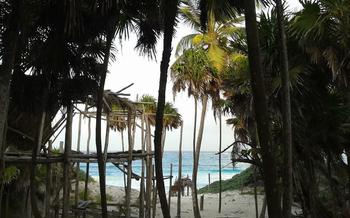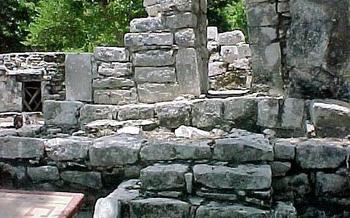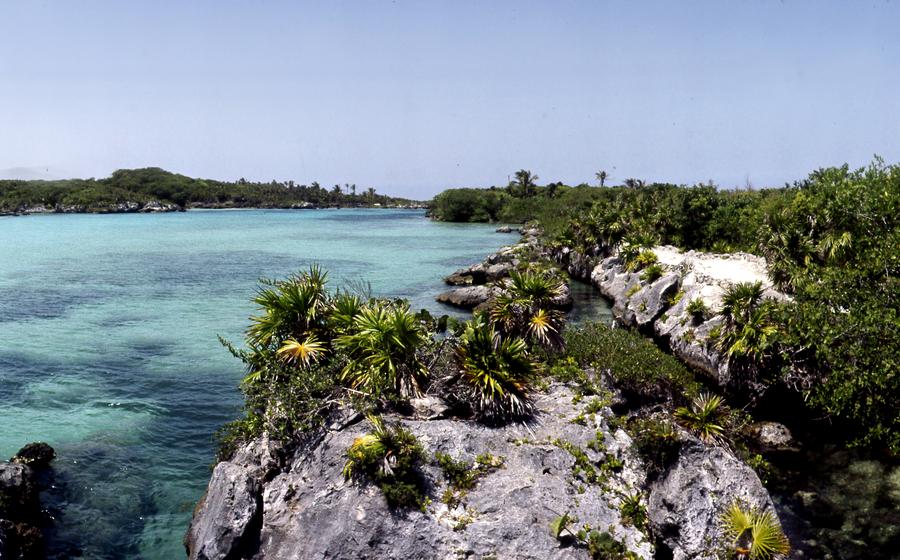
Cenote Kankirixche
- Cenote Kankirixché: A Journey into History and Nature
- Natural Beauty of Cenote Kankirixché:
- Getting to Cenote Kankirixché
- Entrance Fees and Hours of Operation:
- What to Bring to Cenote Kankirixché:
- Exploring the Cenote's Caves
- Photography Tips for Cenote Kankirixché:
- Dining Options Near Cenote Kankirixché:
- Sustainable Tourism Practices at Cenote Kankirixché
- Safety Measures at Cenote Kankirixché
- Additional Tips for Planning Your Visit
- Best Time to Visit
- Avoiding Crowds
- Packing Essentials
- Planning Your Itinerary
- Local Customs and Etiquette: Honoring the Heart of Xel-Há
- Suggested Itineraries for Cenote Kankirixché
- Insider Tip: Uncovering Hidden Gems and Local Secrets
Cenote Kankirixché: A Journey into History and Nature
The cenote Kankirixché, nestled within the lush greenery of Xel-Há Park, is a natural wonder with a rich history and cultural significance. Its crystal-clear waters hold secrets of ancient civilizations and offer a glimpse into the mystical world of the Maya.
Legends and Myths:
According to Mayan legends, cenotes were considered sacred portals to the underworld, known as Xibalba. The cenote Kankirixché, with its deep, mysterious waters, was believed to be a gateway to this realm. It was said that those who dared to swim in its depths could communicate with the spirits of the underworld and gain knowledge of the afterlife.
Archaeological Discoveries:
Archaeological excavations conducted in the area have unearthed ancient artifacts, including ceramics, tools, and human remains, providing valuable insights into the lives of the Maya who inhabited this region. The cenote's role as a ceremonial site is further supported by the discovery of offerings and ritual objects, suggesting that the Maya held religious ceremonies and rituals at this sacred site.
Preservation Efforts:
Recognizing the cultural and environmental significance of the cenote, Xel-Há Park has undertaken extensive preservation efforts to protect this natural treasure. The park's commitment to sustainable tourism includes measures such as limiting the number of visitors, implementing strict guidelines for activities, and conducting regular monitoring of the cenote's ecosystem to ensure its long-term conservation.
Natural Beauty of Cenote Kankirixché:
The cenote's geological formations are a sight to behold. The result of millions of years of erosion, the cenote's walls are adorned with intricate carvings and patterns, creating a mesmerizing backdrop for your underwater adventures. The crystal-clear turquoise waters of the cenote provide excellent visibility, allowing you to explore the vibrant marine life that calls this cenote home.
The cenote is surrounded by lush vegetation, creating a serene and tranquil atmosphere. The lush greenery provides a habitat for various bird species, whose melodious songs fill the air. The trees offer shade from the warm Mexican sun, creating pockets of coolness where you can relax and take in the beauty of your surroundings.
The cenote is home to a diverse array of marine life, including colorful fish, turtles, and even the occasional stingray. Snorkeling or diving in the cenote is a must-do activity, as it allows you to get up close and personal with these fascinating creatures. The cenote's crystal-clear waters make it easy to spot even the smallest and most elusive creatures, providing you with a truly immersive experience.
Getting to Cenote Kankirixché
Location within Xel-Há Park
Cenote Kankirixché is situated within the Xel-Há Park, a renowned natural aquarium and eco-park. The park encompasses a diverse range of attractions, including cenotes, lagoons, caves, and a beautiful beach. Cenote Kankirixché is conveniently located within the park, making it easily accessible to visitors.
Transportation Options Available
Reaching Xel-Há Park is a breeze, with various transportation options at your disposal. You can opt for a hassle-free experience by booking a tour that includes transportation to and from your hotel. Alternatively, you can rent a car and enjoy the flexibility of exploring the region at your own pace. Public transportation is also available, with buses departing from major cities and towns.
Distance from Major Cities and Towns
Xel-Há Park is conveniently located just a short distance from several major cities and towns. From Cancun, the journey takes approximately 1 hour and 30 minutes by car. Playa del Carmen is even closer, with a driving time of around 45 minutes. From Tulum, the drive takes approximately 1 hour.
Recommended Routes for a Hassle-Free Journey
To ensure a smooth and enjoyable journey, we recommend taking the following routes:
- From Cancun: Take Highway 307 towards Tulum and follow the signs for Xel-Há Park.
- From Playa del Carmen: Take Highway 307 towards Cancun and look for the signs for Xel-Há Park.
- From Tulum: Take Highway 307 towards Cancun and follow the signs for Xel-Há Park.
Once you arrive at Xel-Há Park, follow the signs to Cenote Kankirixché, and you will soon be immersed in its breathtaking beauty.
Entrance Fees and Hours of Operation:
Entrance Fees:
- General Admission (Adults): 2,400 Mexican Pesos (MXN) or approximately $120 USD
- Children (5-11 years): 1,200 MXN or approximately $60 USD
- Infants (0-4 years): Free admission
Discounts and Special Offers:
- Online Booking: Save 15% by purchasing tickets online in advance.
- Package Deals: Combine your cenote visit with other Xel-Há Park attractions for a discounted rate.
Hours of Operation:
- Summer (March-October): 8:30 AM to 6:00 PM
- Winter (November-February): 8:30 AM to 5:00 PM
Seasonal Variations:
- During peak season (December-March), the cenote tends to be busier. Consider visiting during the shoulder months (April-May and September-October) for a more relaxed experience.
What to Bring to Cenote Kankirixché:
When packing for a day at Cenote Kankirixché, remember to bring essential items to ensure a comfortable and enjoyable experience.
Swimwear and Cover-ups: Pack a swimsuit or bikini, as swimming is one of the main activities at the cenote. Bring a light cover-up or sarong to protect your skin from the sun when not in the water.
Water Shoes or Sandals: The cenote's rocky and slippery surfaces require proper footwear. Water shoes or sandals provide good traction and protect your feet from sharp objects.
Towel: Bring a large towel to dry off after swimming or lounging by the cenote. Choose a quick-drying towel for convenience.
Waterproof Camera: Capture the stunning underwater world of the cenote with a waterproof camera. Look for a camera that can withstand depths of at least 10 meters.
Snorkeling Gear: If you plan to snorkel, consider bringing your own mask, snorkel, and fins. However, you can also rent snorkeling equipment at the cenote.
Sunscreen and Insect Repellent: Protect yourself from the sun's harmful rays with a high-SPF sunscreen. Insect repellent is also advisable to keep mosquitoes and other insects at bay.
Snacks and Drinks: While food and beverage options are available at Xel-Há Park, bringing your own snacks and drinks can save you money and ensure you have your favorite items.
Cash or Credit Card: Although most establishments within the park accept credit cards, it's good to have some cash on hand for small purchases or tips.
Exploring the Cenote's Caves
For the more adventurous visitors, guided cave tours are available to explore the hidden depths of Cenote Kankirixché. These tours take you through fascinating chambers and passageways, showcasing the intricate formations and unique ecosystem of the cave. Discover stalactites and stalagmites that have formed over thousands of years, and learn about the delicate balance of life that exists within this underground world.
Before embarking on your cave exploration, ensure you are equipped with proper safety gear and follow the instructions of your guide. The caves can be slippery, so wear sturdy shoes and be prepared to get wet. You will also be provided with a flashlight to illuminate the dark corners of the cave, allowing you to marvel at the hidden wonders that lie beneath the surface.
As you explore the caves, you will gain insights into the geological processes that have shaped this natural wonder. Discover ancient fossils and remnants of past life, providing a glimpse into the history of the region. Whether you are a seasoned cave explorer or a first-timer, Cenote Kankirixché offers an unforgettable adventure that combines natural beauty with a touch of mystery and exploration.
Photography Tips for Cenote Kankirixché:
For photography enthusiasts, Cenote Kankirixché presents a stunning canvas to capture the beauty of nature. To help you create memorable shots, here are some valuable tips:
Embrace Natural Light: - Utilize natural light to your advantage. The best time for photography is during the golden hours, shortly after sunrise or before sunset, when the light is soft and warm.
Adjust Your Camera Settings: - For underwater shots, use a waterproof case or housing to protect your camera. Adjust the white balance to "underwater" or "marine" to compensate for the blue tint.
Capture Marine Life: - To capture vibrant photos of marine life, use a macro lens or a zoom lens with a wide aperture. Get close to the subjects and focus on their unique features.
Avoid Common Mistakes: - Avoid using flash photography underwater, as it can scare away the marine life and create unnatural colors. - Be patient and wait for the right moment to capture the perfect shot.
Dining Options Near Cenote Kankirixché:
For a convenient and hassle-free dining experience, Xel-Há Park offers a variety of dining options to suit every taste and budget. From casual snacks to gourmet meals, visitors can choose from a range of restaurants, cafés, and bars located throughout the park.
La Isla de las Hamacas is a popular restaurant serving Mexican and international cuisine, with a focus on fresh seafood and local ingredients. El Mirador offers a more upscale dining experience, with a menu featuring gourmet dishes and panoramic views of the lagoon. For a quick bite, El Jardín offers a variety of snacks and refreshments, including sandwiches, salads, and fresh fruit.
Visitors can also enjoy a variety of drinks and cocktails at the park's bars, including the Coco Loco Bar, the Manglar Bar, and the Tequila Bar. To ensure a smooth and stress-free dining experience, it's advisable to plan your meals in advance. Restaurants can get busy during peak hours, so it's recommended to make reservations if you have a specific dining preference or if you're traveling with a large group.
Sustainable Tourism Practices at Cenote Kankirixché
Cenote Kankirixché and Xel-Há Park are committed to preserving the natural beauty and biodiversity of the region. Sustainable tourism practices are a top priority to ensure that the cenote remains a pristine destination for future generations.
The park has implemented several eco-friendly initiatives, such as using renewable energy sources, recycling programs, and water conservation measures. Visitors are encouraged to participate in these efforts by reducing their environmental impact.
Responsible tourism practices are essential for maintaining the health of the cenote. Visitors should avoid using sunscreen and insect repellent containing harmful chemicals that can pollute the water. Additionally, it is important to stay on designated trails and avoid disturbing the wildlife.
By following these guidelines, visitors can help protect the cenote's unique ecosystem and ensure its beauty is preserved for years to come. Sustainable tourism is a shared responsibility, and every visitor can make a positive impact.
Safety Measures at Cenote Kankirixché
For a Safe and Enjoyable Experience
Cenote Kankirixché prioritizes the safety of its visitors, ensuring a carefree and enjoyable experience. Lifeguards and safety personnel are stationed throughout the area, vigilantly monitoring the swimming areas and providing assistance as needed. Designated swimming zones are marked for visitors to ensure they remain within safe boundaries. Additionally, safety guidelines and instructions are provided to all visitors upon entry, covering important aspects such as swimming etiquette, cliff jumping safety, and emergency procedures. By adhering to these guidelines and following the instructions of the safety personnel, visitors can create a safe and memorable experience for themselves and others.
Additional Tips for Planning Your Visit
Best Time to Visit
The best time to visit Cenote Kankirixché is during the shoulder seasons, which fall between April and May and September and October. During these months, you can expect fewer crowds and more pleasant weather, without the intense heat and humidity of the summer months. Keep in mind that the cenote is open year-round, so you can still enjoy it during other times of the year, but be prepared for larger crowds during peak season.
Avoiding Crowds
To avoid the crowds, consider arriving early in the morning or late in the afternoon. The cenote is typically less crowded during weekdays compared to weekends. If you're visiting during peak season, try to plan your visit on a weekday to have a more tranquil experience.
Packing Essentials
Remember to pack essentials like sunscreen, insect repellent, and a hat to protect yourself from the sun and mosquitoes. Bring comfortable clothing and footwear that you can wear in and out of the water. Consider packing a waterproof bag to keep your belongings dry while swimming or snorkeling.
Planning Your Itinerary
Plan your itinerary to make the most of your visit. Allocate enough time to explore the cenote, swim, snorkel, and relax on the sun loungers. If you're interested in exploring the cenote's caves, book a guided tour in advance to secure your spot.
Local Customs and Etiquette: Honoring the Heart of Xel-Há
As you immerse yourself in the wonders of Cenote Kankirixché and Xel-Há Park, it's essential to be mindful of local customs and traditions. Show respect for the rich cultural heritage of the region by interacting with the local community in a friendly and respectful manner. Your positive interactions with locals will not only enhance your experience but also contribute to the preservation of the vibrant cultural tapestry that makes this place so unique.
Support local businesses and artisans by purchasing souvenirs and handicrafts crafted with love and tradition. These purchases not only contribute to the local economy but also help preserve the unique cultural expressions of the region. Embrace the spirit of community by engaging in conversations with locals, learning about their customs, and sharing stories. Your genuine interest in their way of life will be met with warmth and hospitality, creating meaningful connections that will stay with you long after your visit.
Remember, cultural sensitivity is key. Be respectful of local beliefs and practices, and avoid engaging in actions or conversations that may be considered offensive. Dress modestly when visiting sacred sites or interacting with the local community, and be mindful of noise levels to avoid disturbing the tranquil atmosphere of the cenote and its surroundings. By embracing local customs and traditions, you not only enhance your travel experience but also contribute to the preservation of the cultural heritage that makes Xel-Há a truly special destination.
Suggested Itineraries for Cenote Kankirixché
Tailoring Your Experience to Your Interests:
Whether you're a nature enthusiast, an adventure seeker, or a traveler looking for relaxation and tranquility, the cenote and Xel-Há Park offer a variety of experiences to cater to your interests.
Insider Tip: Uncovering Hidden Gems and Local Secrets
Beyond the main attractions of Cenote Kankirixché, Xel-Há Park offers a treasure trove of hidden spots waiting to be discovered. Venture off the beaten path to find secluded swimming areas where you can immerse yourself in the tranquility of the cenote's pristine waters, away from the crowds. Explore the park's lesser-known trails to encounter unique attractions that often go unnoticed by visitors. Ask the friendly park staff for recommendations on secret spots and local favorites to make the most of your Xel-Há experience. Embrace the spirit of adventure and uncover the hidden gems that await those who dare to explore beyond the ordinary.
